
 |
|||||||
|
|
| Lotto Caravaggio Optics Focal lengths Oil paint No documentation Arnolfini portrait Talent Problems tracing Demonstrations Technology Future discussions Summary
"Opticality" in early Renaissance painting:
|
 |
A plausible schematic of the Hockney/Falco setup shows the silverpoint on a small table, a concave mirror and the projected image on the canvas 40% farther away (as required by the magnification). |
First, as remarked by Bernhard Sharratt in his review of Secret Knowledge, the correspondence between the images, while close, is not "almost perfect," as claimed by Hockney and Falco (even for the individual patches that match quite well). Nevertheless, let us accept that the match is excellent.
Falco demonstrates that there are three "exposures," so to speak -- three image patches for which the correspondence is quite good. The first patch consists of the mouth, nose and much of his face at the left. If the painting is then shifted to the right (by 36 pixel-block steps in my electronic images, or about 4mm on the silverpoint), then the earlobes and collars match well. If the painting is then shifted up by 18 pixel-block steps, the pinna (top of ear) matches well. These shifts -- and the Hockney/Falco explanation for them and my alternative -- will be important in the analysis below.
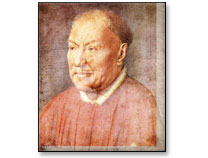 |
 |
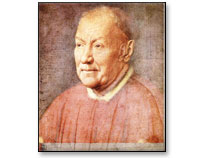 |
||
Hockney and Falco write: "The painted portrait, created the following year, was 40% larger than the drawing, and yet -- observe -- when recast at the same size, matches it almost perfectly. How else to account for the convergence except by way of some sort of optical projection?"
"How else"? Three techniques immediately spring to mind: "eyeballing," grid constructions, and pantographs.
Consider the first technique for duplicating the Albergati portrait: eyeballing. Given the fidelity with which some modern representational artists can copy from nature or from other paintings without optical aids, it is not unreasonable to entertain the notion that the oil painting was "eyeballed" (in Mr. Hockney's term). I've seen many students in the National Gallery and elsewhere copying masterpieces with great fidelity. We must not forget that that in the case of the Albergati portrait, the copier would be the same artist as that for the original, and hence more likely to give an accurate copy. At the very least, such eyeballing does not rely on technology that never appears in the historical record (see below).
Now consider the second technique for duplicating the Albergati silverpoint (and the one I favor): grid constructions. In the grid method, a rectangular grid is drawn over the original silverpoint or constructed from threads held taught across its surface so as not to mark the original (but see below).
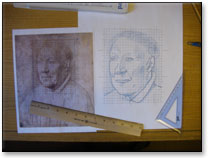 |
Grid construction for the enlargement of the Albergati portrait. |
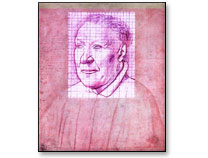 |
When the enlarged drawing is electronically reduced and aligned to overlap the original silverpoint, the correspondence is excellent. |
You can see this by performing the following extremely simple experiment. Place a notebook or paperback book on a flat tabletop -- this will represent one of van Eyck's image surfaces (paper or canvas). Now randomly "bump" the notebook. Now randomly "bump" it again in another direction. Unless you planned otherwise, the book became
rotated
just a bit in the process. In fact, there is no detectable rotation for the image patches in the van Eyck image pairs. More importantly, it is highly unlikely that your any of your bumps moved the notebook exactly
horizontally
or
vertically
.
The first diagram illustrates random bumps, as we might expect in the Hockney/Falco theory since there is no compelling preference for horizontal or vertical bumps. The second illustrates one "lucky" horizontal bump. The third illustrates two "lucky" bumps -- one horizontal and one vertical -- and would be extremely unlikely in the Albergati portraits according to the Hockney/Falco theory. In fact, though, the right diagram shows the actual shifts, measured in units of pixel-blocks in Adobe Photoshop, where M corresponds to the mouth patch in alignment, the L to the earlobe patch in alighnment and the P to the pinna patch.
The horizontal and vertical shifts are easily explained in the grid construction: van Eyck miscounted the grid square in the horizontal or vertical directions or for artistic reasons wanted to resize the head slightly while still employing the grid. The grid explanation goes further: it explains the relative distances of the shifts. If van Eyck miscounted by one grid square in the vertical direction and two grid squares in the horizontal direction, then the ratio of these distances would be 1:2, just as we find (18:36).
But the grid construct explains even more. Go back and expand the image of the silverpoint and notice the two vertical lines running the full height of the work. (A dim third vertical line between them, running partway down the image, as well as a very dim region of square grids at the left are visible too.) These are just the lines that are required by the grid construction method, and their separation corresponds to the relative shift (36 pixel-blocks) that we found above. I'm seeking an infra-red image of the oil painting to reveal any underdrawing, and will post the image here as soon as it becomes available.
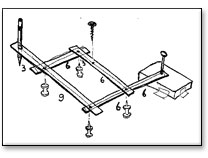 |
|
A pantograph. These mechanical tracing devices (German: Storchenschnabel, or "stork's beak"!) have been used for copying images and paintings for centuries. |
the pantograph at right, linked to a pointer by bars and axles, then becomes aligned with the corresponding point on the canvas, which the artist then marks. In this way, the pantograph is used to draw the three-dimensional bust.
The putto at the lower right is tracing a small flat picture on the table and the attached pantograph moves a pencil and thereby draws the image at a larger scale. Although we don't have records of the use of such a device by van Eyck, this simple device was used by Leonardo a few decades later to copy and scale some of his images.
Before we leave the Albergati portrait, we should consider the suggestion made in passing by Mr. Hockney: that the small pupils in the portrait indicate the sitter was under intense illumination, presumably sunlight, as required by the Hockney/Falco projection method. Indeed, small pupils are consistent with bright illumination, but there are other explanations. Small pupils arise frequently in the elderly for a number of other, biological reasons. If they are due to bright illumination, though, we can only wonder why such small pupils do not appear in other Renaissance portraits purportedly made under bright illumination required by the Hockney/Falco method.
Summary: The explanation through grid constructions is principled, parsimonious and elegant. It explains numerous facts -- such as why the shifts between patches are horizontal and vertical and their distances are the simple ratio 1:2. According to the Hockney/Falco all these facts are highly unlikely; other facts are not even considered such as two vertical rule lines in the silverpoint, and their mutual separation. Modern simple reenactments support the grid construction explanation while no such reenactments have been done for the Hockney/Falco theory. Finally, the grid construction relies on technology clearly available to van Eyck while the Hockney/Falco explanation relies at its very core upon what would have been the most sophisticated optical instrument of its day, for which there are myriad technical problems and for which we have no corroborating textual evidence (see below).
| https://www.webexhibits.org/ |